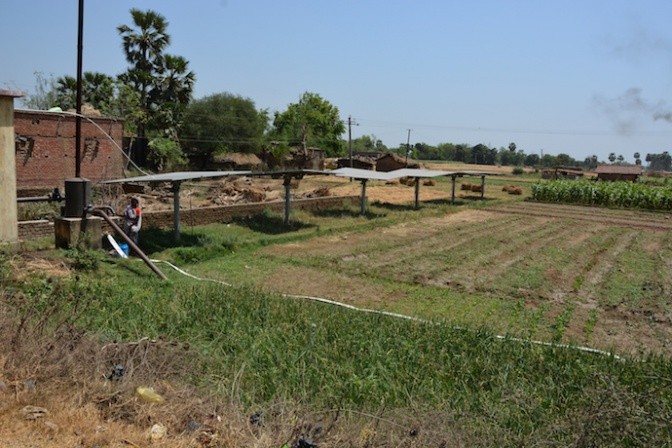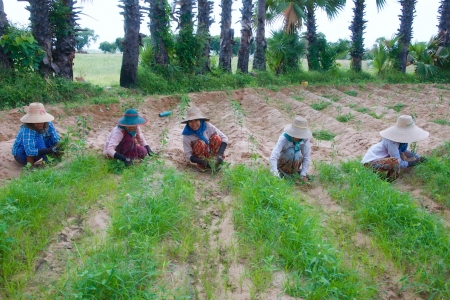By Tushaar Shah and Shilp Verma
The recommendations outlined in this post were shared with India's Finance Minister during pre-budget consultations. The budget speech earmarked Rs. 400 crores (USD 67 million) for a new scheme to promote solar power driven agricultural pumps. How the scheme will be implemented will be clear in the coming days.
Rethinking farm electricity subsidies in India
50 years after inheriting the world’s largest canal irrigation infrastructure from the British Raj, India emerged as the world’s biggest user of groundwater in irrigation. Today, around 70 million hectares of Indian farm lands get full or supplemental irrigation from over 20 million tubewells while government canals barely wet 15 million ha.
 “I have never before seen such a large green patch in my village in summer”, we were told by Kishan Kanhaiya, operator of one of the two deep community tubewells now equipped with 7.5 kWp solar pump in the Nalanda District. Photo: Tushaar Shah
“I have never before seen such a large green patch in my village in summer”, we were told by Kishan Kanhaiya, operator of one of the two deep community tubewells now equipped with 7.5 kWp solar pump in the Nalanda District. Photo: Tushaar ShahThis groundwater boom is founded on the opiate of perverse subsidies on farm electricity supply. What began as an innocuous promotional measure in the 1970’s turned into a full-scale public policy monster by the end of the millennium. In India’s western corridor, from Punjab down to Tamilnadu, this led to relentless groundwater depletion and bankrupt electricity utilities. In the eastern corridor, sitting on abundant aquifers, the countryside got de-electrified; and irrigation by the poor has been impeded by high and rising costs of diesel.
How can we improve the resiliency of farmers to changing climate, depleting aquifers, and rising energy prices?
Game Changer
Every year, come summer, farmers all over Bihar are forced to take a holiday from farming. Irrigating in summer with diesel pumps is a losing proposition. But in a field visit last week to Gonkura village of Bihar’s Nalanda district, we saw a different scenario.
“I have never before seen such a large green patch in my village in summer”, we were told by Kishan Kanhaiya, operator of one of the two deep community tubewells now equipped with 7.5 kWp solar pump.
Diesel pump owners charge Rs 20-22 to irrigate a katha (150 katha = 1 hectare); Kishan Kanhaiya charges only Rs 5 because sunlight comes free. He mentioned a farmer who stopped going to Alang in Gujarat for ship-breaking work now that the solar pump offers affordable irrigation on demand.
Solar pumps hold out the promise of transforming farming and livelihoods in the eastern Ganga basin. The sun shines brighter and longer in summer when irrigation is most needed and less so during monsoon when rains water the crops.
The large land footprint of solar panels was a worry in land-scarce eastern India; but we found some solar farmers who are already growing cucumber, tomatoes and lucern underneath the solar panels. Imagine India’s 20 million irrigation wells retrofitted with solar panels; these can be a game changer for eastern India’s agriculture.
Downside
For all these positives, the solar pump’s chief negative is its high capital cost. In the booming bazaar for solar panels in Patna’s Exhibition road, dealers told us that modal prices of PV modules is Rs 48000-52000/kVp with Tata, the best brand in the market selling for Rs 72000/KVp. For a 5 KVp assembly, the panel cost itself would be upward of Rs 2.5 lakh. Add an imported DC pump and other paraphernalia, and solar goes out of reach of most Indian farmers.
Luckily however the precipitous and continuing fall during recent years in global prices of PV cells offers a ray of hope. For now, state governments are promoting solar pumps by offering 80-90 per cent capital cost subsidies. This is where radical new long-term thinking is needed. The current approach of promoting solar pumps only as a green solution for off-grid communities is based on patchy and piecemeal thinking. Solar pumps promise India much more. The need is to promote them as an integrated energy-water-livelihoods solution.
Turbocharge Ganges Water Machine
In groundwater-abundant eastern India, the aim of the solar pump promotion policy should be to kickstart the Ganges Water Machine by liberating agriculture from high-cost diesel. With their high fixed costs but near zero operating cost, solar pump owners will be aggressive sellers of irrigation services to neighboring farmers.
The strategy should aim to stimulate vibrant, deep and broad irrigation service markets at the village level. This needs a program that:
- offers a flat subsidy of say Rs. 30,000/kVp (instead of pro-rata subsidy which leads to gold-plating and corruption);
- allocates substantial funds (of the order of around Rs. 50,000 crore) over a 5-year period for Bihar, Orissa, Assam, West Bengal, Eastern UP, Chhattisgarh, and Jharkhand so that a large number of suppliers compete to get a share in a buyers’ market;
- include support to establish buried pipe network to neighboring farmers to stimulate competitive water markets;
- does not put undue restrictions on the size of the pump and PV array that farmers can acquire;
- oblige suppliers to provide 5 year maintenance guarantee; and
- establish rigorous third-party monitoring to ensure that suppliers keep their side of the deal.
A program on this scale can install 15,000-17000 MW of groundwater pumping capacity in eastern India, equivalent to 3-3.4 million 5 horsepower electric pumps, and create gross irrigation potential of 18-20 million ha. This irrigation potential would come at Rs 25,000/ha compared to 10 times as much that we invest in canal irrigation potential
Fix electricity-groundwater nexus in western India
In India’s western corridor, the aim of solar pump promotion strategy should be to:
- reduce the deadweight subsidy burden on DISCOMs;
- reduce the huge carbon footprint of the groundwater economy; and
- remedy perverse incentive to over-exploit groundwater with subsidized electricity.
Current subsidy regimes fail to achieve any of these. Most governments restrict subsidies to 2 to 3 kVp pumps; thus solar pumps are additional to electric pumps rather than replacing them. Small annual subsidy budget for each state has meant a high-margin-low-volume market for PV systems. Finally, pro-rata subsidy has produced strong incentives to inflate costs and gold-plate the product offering.
Our recommendation is to remove limits on solar capacity, provide a flat subsidy of around Rs 30,000/kVp, create a sizeable non-lapsable Solar Pump Promotion Fund, incentivize tubewell owners to surrender grid power connection in lieu of subsidized solar pump and install net-metering to buy surplus solar power from farmers at a guaranteed feed-in tariff of say Rs 8/kWh.
Under such a regime, the farmer uses his land and sunlight to produce solar power just as any other crop to meet his own needs and to sell in the market. A 20 kVp solar pump has a land footprint of 0.03 ha (300 m2). At 20 percent efficiency and with intensive management, this PV assembly would generate up to 34,560 kWh/year.
At the present subsidized grid power prices, farmers in western India use on average 11,500 kWh of power per connection per year. Assuming that a solar farmer will use the same amount of power, he will have a surplus of 23,000 kWh/year to sell to the grid which, at a feed-in tariff of Rs 8/kWh, can yield him an income of Rs 184,000/year from a 300 m2 plot. Solar power may well be the most lucrative crop a farmer can grow.
From Dumb to Smart Subsidy
Our recommendation is not easy to implement, but it could transform the perverse electricity-groundwater nexus in India’s western corridor, from Punjab to Tamil Nadu:
First, a solar pump of appropriate size will ensure farmers stable, uninterrupted 6-8 hours of power for irrigation during day time. Second, the farmer will have an incentive to maximize surplus solar power sales to the grid after pumping use because he gets paid for it. Third, to save power, farmers will have strong incentive to adopt drip irrigation, mulching, greenhouses. Fourth, solar PV suppliers have incentive to maximize sales, to offer competitive prices in a large and growing market for PV for pumps. Fifth, the governments will not need to find large swathes of land for green-field MW-scale solar plants. Sixth, each solar pump that retires an electric pump saves the electricity utility around Rs 50,000/year of farm power subsidy. Moreover, taking tube wells off the rural grid makes DISCOM’s (India’s electricity utilities) rural operations vastly simpler and financially viable.
All in all, a forward-looking smart promotional strategy for solarizing Indian irrigation can kill several birds with one stone.
The recommendations outlined in this post were shared with India's Finance Minister during pre-budget consultations. The budget speech earmarked Rs. 400 crores (~ US$ 67 million) for a new scheme to promote solar-power driven agricultural pumps. How the scheme will be implemented will be clear in the coming days. For more information, email Shilp Verma at shilpv(at)gmail(dot)com.









Comments
This is a very interesting topic that could provide solution to the lack of water in eastern India, when working jointly taking advantage of falling global prices of photovoltaic cells and support he government to implement and subcidiar solar pumps for over-exploitation of groundwater. one could achieve water supply in vulnerable sectors thus creating a green solution for the community by promoting an integrated livelihoods water-energy to generate resources that promote sustainable development and sustainable solution indues peoples.